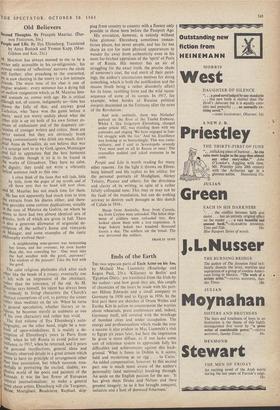Ends of the Earth
THE two separate parts of Each Actor on his Ass, by Micheal Mac Liammair (Routledge and Kegan Paul, 25s.), 'Killarney to Berlin' and 'Egyptian Diary,' are translated from the Irish by the author—and how good they are, this couple of chronicles of the tours he made with his part- ner Hilton Edwards and a small company to Germany 'in 1950 and to Egypt in 1956. In the first part there are sketches of Orson Welles and Eartha Kitt in action to counterpoint the worries about rehearsals, press conferences and, indeed, Germany itself, still covered with the wreckage of bombed cities and under occupation. The energy and professionalism which made the tour a success is also evident in Mac Liammoir's visit to Egypt six years later, but here the impression he gives is more diffuse, as if one lacks some sort of reference system to appreciate fully his difficulties and achievements against this back- ground. 'What is funny in Dublin is, it seems, bald and mysterious as an egg . . . to Cairo.' An added compensation. however. In this second part one is much more aware of the author's personality (and nationality) breaking through. An aside on the English passion for the sea: 'It has given them Drake and Nelson and their greatest imagery; to us it has brought conquest, isolation and a host of drowned fishermen.' Arnold Toynbee's Between Oxus and Jumna (O.U.P., 21s.) is the story of a journey the philo- sopher of history made in the spring of 1961 through north-west India, West Pakistan and Afghanistan. This book is rather mole than a con- ventional travelogue, for as Toynbee moves west- wards from Delhi to Peshawar and so across the Khyber in a truck, there is a commentary-in- depth which only he could give. The best parts of the book are those which deal with Afghanistan, 'a keypoint in the structure of em- pires.' From Kabul the author went to Kanda- har and so north to Herat, formerly one of the great cities of Islam, which was spared the wrath of the Mongols by timely submission. The climax of the journey came when the party reached the banks of the Oxus, with Soviet Tajikistan just across the river. On the way back to Karachi, Toynbee gives a magnificent descrip- tion of the abandoned British forts on the North- West Frontier, comparing these ruins of the Durand Line to those of Hadrian's Wall. Par- ticularly good is the bit on Razmak, where after only thirteen years bushes and briars were grow- ing in the streets of the largest British canton- ment on the frontier. Illustrations, particularly of the mediaeval mosques of Afghanistan, are well above average.
Sylvia Matheson worked as a part-time ar- chwologist with a French expedition to Afghanistan; her adventures excavating some of the remains of the past on which Dr. Toynbee digresses complement the sweep of his narrative with human detail. For although there are some impressive asides in Time Off to Dig (Odhams, 25s.) on, for example, the mechanics of the Car- bon-14 test and the relationship between Sir 'Leonard Woolley's Mesopotamian discoveries and the site near Kandahar where this expedi- tion worked during 1955-57, one appreciates best the discussion of the problems of day-to-day living in Afghanistan. Scorpions, ants, the heat of the day and the behaviour of Afghan labourers all worry the archeologists. There are also the peculiar psychic stresses of living in the country cut off physically from the rest of the world by the Hindu Kush and the Oxus, spiritually by the local harsh, fundamentalist in- terpretation of Islam.
After spending what were obviously five pleasant years in the US Consular Service in North Africa, Mr. John Anthony has produced an account of a love affair between himself and the most civilised country of the Maghreb, About Tunisia (Geoffrey Bles, 21s.). Politics take second place in this chronicle, which is mostly about customs, places and people the author got to know, enjoying them all the more for de-Westernising himself in the process as much as possible. One of his acquaintances was a Moorish painter, another great and good friend was a belly-dancer, while Roxane, a socially mobile, sophisticated hostess, was a type well known here, too, having acquired 'a small reputation as a sibyl by predicting marriages, love affairs and a divorce or two among her friends.' There are also some set descriptive pieces on Cape Bon, where one can see across the narrows to Sicily, on Carthage, and on Gabes, Gafsa and the south. Here, regretfully, one has to mark Mr. Anthony down in com- parison with Norman Douglas.
The Seven Cities of Cibola, by Stephen Clissold (Eyre and Spottiswoode, 25s.), takes its title from Hakluyt: 'The Spaniards have notice of seven cities which old men of the Indians show them should lie towards the north east from Mexico. . . .' Mr. Clissold has in fact written a short study of the attempt by the second generation of conquistadores to discover an Eldorado in the Rockies. After several abor- tive expeditions and incredible difficulties, Coronado's men eventually reached the site of the first of the cities, Cibola. And what lay in front of them, 'another Mexico with its bar- baric splendours and inexhaustible treasures"? Unfortunately, no; nothing but 'a mean, tene- ment-like huddle of stone and adobe buildings'. Moreover, one last push eastwards to the plain of the Middle West and then the supposed site of yet another golden city, Quivira. produced no result. Recent research has established this Ultuna Thule of the great age of Spanish e$' ploration to be the. village of Lindsberg. Mac'







































 Previous page
Previous page